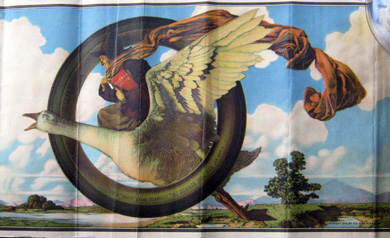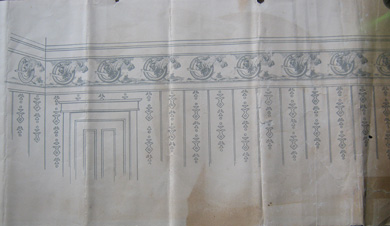 |
|
|||
 |
 |
|||
Copyright © Harry Rinker, LLC 2015 Questions
and Answers
QUESTION: I have several examples of a wallpaper border featuring an image by Maxfield Parrish offered as a Fisk Rubber Company giveaway. The image is from Parrish’s illustrations for an 1897 edition of Frank L. Baum’s “Mother Goose in Prose.” Mother Goose, wearing a black witch’s hat and holding a Mother Goose book, sits astride a goose that is flying through a Fisk Tire. The pieces measure 14 inches by 8 1/2 inches. In the bottom right corner is “COPYRIGHT 1919 BY THE FISK RUBBER COMPANY.” The back states that this is one piece of a room border and that Fisk would be happy to provide enough examples to do a complete room border at no charge. Years ago, I saw a framed example in mint condition for sale on the Internet for $1,450.00 but did not make a record of the site. What is my unframed example worth? – DB, Houston, TX< Email Question
ANSWER: Noyes W. Fisk acquired the Spaulding and Pepper Company in 1898, renaming it the Fisk Rubber Company. By 1917, the Fisk Rubber Company had more than 4,500 employees. The company was headquartered in Chicopee Falls, Massachusetts. Immediately following World War II, the company had plants in Jewett City, Connecticut, New Bedford, Massachusetts, and Pawtucket, Rhode Island. Fisk Tire suffered greatly during the Great Depression. In 1940, United States Rubber (Uniroyal) acquired Fisk. See: https://en.wikipedia.org/wiki/Fisk_Tire_Company Internet information is sparse regarding the Fisk Tire Parrish wallpaper. A listing for the panel suggested there were two additional panels in the series. Based on the illustration on the back of the panel you have, this is not true.
Maxfield Parrish moved to Plainfield, New Hampshire in 1908, two years after the commission to provide the illustrations for L. Frank Baum’s “Mother Goose in Prose” launched his career. As an illustrator, Parrish worked for Colgate, “Collier’s,” Edison-Mazda Lamps, “Life,” Oneida Cutlery, and Wanamaker’s. An internet seller [http://www.dreamgardener.com/postersqmothergoose. html] is asking $1,250.00 plus $30.00 shipping for a framed example of the central panel. Asking is not the same as getting. The framing on the panel appears to be period, similar in color and style found on many early Parrish prints. Parrish is no longer “hot” among collectors. The exceptions are his period artwork. His period prints and other memorabilia became expensive. His art style no longer enamors young collectors. Unframed and in fine condition, the value of a panel of Parrish/Fisk Tire wallpaper is between $500.00 and $600.00. QUESTION: I am a part-time toy dealer. I sell primarily at flea markets and small shows. When shopping flea markets and shows, I continually encounter what I consider to be unrealistic prices for the same toys that I am offering for substantially less. Why is this? – S, Janesville, WI ANSWER: There are three primary reasons: (1) eBay, (2) greed, and (3) hobby sellers. New sellers are far more likely to turn to eBay when researching the potential value of an antique or collectible than they are to a printed price guide and/or doing field research. eBay’s “Buy It Now” pricing structure is a disaster. First, a seller can set any price he/she wishes. Second, most “Buy It Now” items never sell at the listed price. Third, it is common to find the same object on eBay with price variations as much as 300 percent and more. This is why it pays to comparison shop in any sales venue in today’s antiques and collectibles marketplace. Dealers, especially inexperienced ones, are greedy. They want top dollar even if the condition, scarcity, and desirability of the object does not warrant it. Their selling philosophy is: “if you do not buy it, someone eventually will.” This is why you see the same merchandise month after month in some antiques mall cases and booths as well as in flea market and show dealers’ booths. Sooner or later, it would seem the seller would conclude the object is badly overpriced and adjust the price downward. Do not hold your breath. Flea markets, malls, and shows are filled with hobbyist dealers, individuals whose primary business goal is to pay their travel expenses and support their antiques and collectibles buying habits. They do not rely on the income from the sale of their objects to live. They have sufficient income from other sources. Although usually not stated, the real goal of their business is to produce an annual tax write-off for federal and state tax purposes. Ignore the unrealistic prices. Try to avoid snickering or laughing when you encounter them. Remember, they are far more likely to pack more merchandise to take home than you will. QUESTION: After reading a copy of your book “Sell, Keep, or Toss?: How to Downsize a Home, Settle an Estate, and Appraise Personal Property,” my husband and I are ready to take your advice regarding how to downsize our empty nest. We have 12 to 15 pieces of leaded cut glass. A local antiques dealer appraised them. We prefer an “in person sale” (private treaty sale) as opposed to selling them online but are open to suggestions. Do the dealers in the New Hope, Pennsylvania/Lambertville, New Jersey area offer a good prospect? What advice do you have? – SE, State College, PA ANSWER: I am concerned about what value approach the dealer used in his appraisal. Replacement value, what a person would have to be paid in the secondary market to replace a lost or damaged piece, is the standard approach. This is a top market value, a far cry from what you will receive in selling your cut glass. Since you were planning to sell these items, you should have asked the appraiser to use an auction value or private sale value. The difficulty with replacement values is once the owner sees them, he/she has great difficulty letting go of them. In the owner’s mind, this is what the objects are worth. A sale resulting in a lesser amount is a defeat. American cut glass divides into two basic periods: (1) Brilliant Cut Glass, made prior to 1915 and (2) cut glass made after 1920. The first is desirable, albeit not to the same extent as several decades ago. The second is a tough sell no matter what the market. You also need to honestly assess the scarcity of your forms, shapes, and cutting patterns. Are the forms – bonbon dishes, bowls, celery dishes, vases – standard, readily available pieces on the secondary market? Be careful. Most private sellers over grade the scarcity of the material they own. Cut glass is a difficult sell, no matter where the market is located. Young adults have no interest in it. They do not set formal tables or see it as a decorative accessory asset. The biggest problem is cut glass is not dishwasher safe. The heat cycle of dishwashers often causes cut glass to crack. The Plains States are the strongest market for cut glass. My recommendation is to approach one of the leading auction companies such as Tom Harris Auctions in Marshalltown, Iowa, or Jackson’s International Auctioneers in Cedar Falls, Iowa. If your pieces are post-1920 and the form, shape, and cuttings common, do not be surprised if they inform you that they are not interested in selling the collection. Using the cut glass as wedding and holiday gifts might be the most viable alternative you have in terms of getting rid of the pieces. Another alternative is to find a strong regional auction house such as Alderfer’s in Hatfield, Pennsylvania, or Nye & Company Auctioneers and Appraisers in Bloomfield, New Jersey and see if they will take the cut glass. Chances are they will lot the pieces rather than sell them individually. Be happy with whatever money you receive. The time and effort required in your selling these pieces probably will far exceed any moneys you receive. First, you will sell the best pieces quickly, especially if you price them at half full market retail or below. Second, you will be stuck with the lesser pieces for which buyers will be virtually non-existent. While your effort in selling the cut glass is not mission impossible, it will be a long and arduous journey. QUESTION: What is the significance of the different colors – black, green, red, and others – on the wooden handles of 1920s through 1950s kitchenware? Does it have to do with different time periods? – DW, Silverton, OR, Email Question ANSWER: When teaching authenticating, I devote a great deal of time to understanding collecting vocabularies – form, shape, pattern, color, and more. When discussing color, I recommend a person pick a single color such as red, blue, or green and focus on how that color tone changed in popularity from decade to decade. A 1950s green is very different from a late 1920s/early 1930s green, especially when applied to the kitchen. The colors on the handles of kitchenware corresponded to the dominant decorator themes of any given era. In the 1930s, many appliance handles had a soft, pastel green tone. As the 1930s ended and throughout the 1950s, the emphasis was on bold colors, especially red. Think of the color palette of Homer Laughlin’s Fiesta dinnerware. Colors on kitchenware complemented the current fashion colors of kitchen walls and textiles. Pieces were designed to blend in rather than stand out. Study the kitchen advertisements found in the popular household periodicals from the 1920s through the 1960s. Color has value. Although not a primary value, color can influence price. Based on my field experience, value by color appears to be red, blue, green, yellow, brown, black, and white. A blue object can be ugly, but it will sell to a “blue” collector. Although one color or set of colors may be associated with a specific time period, for example, pink/white, turquoise/copper/chrome, or avocado/golden harvest/rust, this did not preclude pieces being made in a wide variety of colors. Today, thanks to the internet, it is possible to obtain contemporary kitchenware in any color and, to some extent, pattern, a buyer may desire.Harry L. Rinker welcomes questions from readers about
collectibles, those mass-produced items from the twentieth and twenty-first centuries.
Selected letters will be answered in this column.
Harry cannot provide personal answers.
Photos and other material submitted cannot be
returned.
Send your questions to: Rinker on Collectibles, 5955 Mill
Point Court SE, Kentwood, MI 49512.
You also can e-mail your questions to
harrylrinker@aol.com.
Only e-mails containing a full name and mailing address
will be considered.
You can listen
and participate in
WHATCHA GOT?, Harry’s
antiques and collectibles radio call-in show, on Sunday mornings between 8:00 AM
and 10:00 AM Eastern Time.
If you
cannot find it on a station in your area,
WHATCHA GOT?
streams live on the Internet at www.gcnlive.com.
SELL, KEEP OR TOSS?: HOW TO DOWNSIZE A HOME,
SETTLE AN ESTATE, AND APPRAISE PERSONAL PROPERTY
(House of Collectibles, an imprint of Random House Information Group, $17.99),
Harry’s latest book, is available at your favorite bookstore and via
www.harryrinker.com.
|
||||

